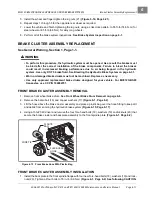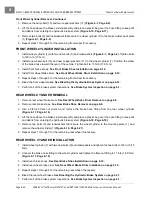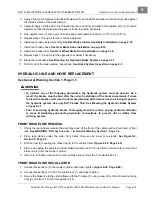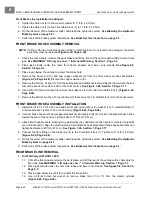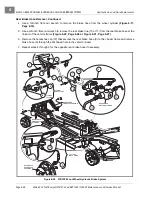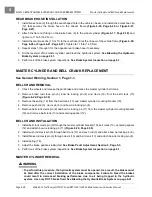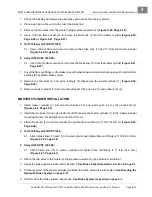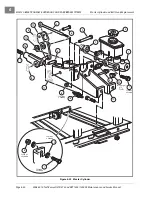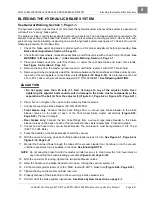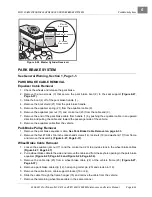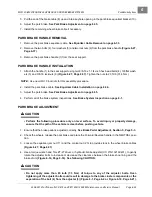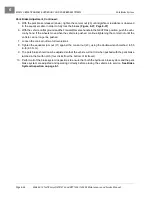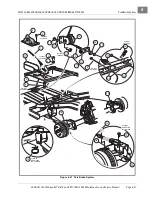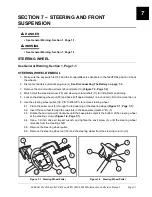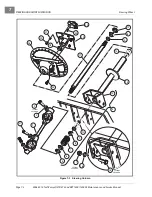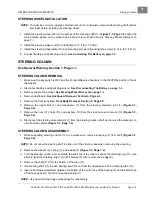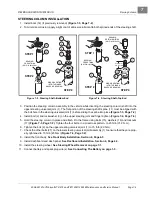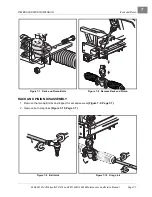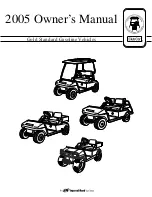
MC012C-BS00 TRANSAXLE: HYDRAULIC AND PARK BRAKE SYSTEMS
Bleeding the Hydraulic Brake System
2006-2010 Turf/Carryall 272/472 and XRT 1200/1200 SE Maintenance and Service Manual
Page 6-31
6
BLEEDING THE HYDRAULIC BRAKE SYSTEM
See General Warning, Section 1, Page 1-1.
The hydraulic system must be free of air. Air enters the hydraulic system whenever the system is opened and
will result in a “spongy” brake pedal.
The master cylinder controls two separate hydraulic sub-systems. The front two wheels are connected to the
smaller, front portion of the brake fluid reservoir, and the rear wheels to the larger portion. One or both sub-
systems may require bleeding, depending on where the hydraulic system was opened. To bleed both, use the
following procedure, front brakes first.
1. Check the brake pedal and master cylinder push rod for proper adjustment before proceeding.
Brake Pedal Adjustment, Section 5, Page 5-3.
2. Chock front or rear wheels, release the park brake, and lift the vehicle with a chain hoist or floor jack.
See
WARNING “Lift only one end...” in
See General Warning, Section 1, Page 1-1.
3. Place jack stands under the outer front frame, or under the rear axle tubes and lower onto stands.
See Figure 5-2, Section 5, Page 5-3.
4. Remove the cap from the master cylinder reservoir and fill the reservoir with DOT 5 brake fluid.
5. Remove each wheel and gently adjust the clearance between the brake shoes and brake drum by turn-
ing each of the two adjusters on the brake cluster
. Use a torque wrench and
a Torx #T-27 driver or hydraulic brake adjuster (CC P/N 102169401).
See following CAUTION.
ý
CAUTION
• Do not apply more than 65 in-lb (7.3 N·m) of torque to any of the adjuster bolts. Over-
tightening the adjuster bolts could result in damage to the brake cluster components or the
separation of the bolt (4) from the adjuster (3) (Figure 6-1, Page 6-2 or Figure 6-19, Page 6-21).
6. Place, but do not tighten, the cap onto the master cylinder reservoir.
7. Connect vacuum type brake bleeder (CC P/N S0010702).
• Front brakes only:
Connect the two hose fittings from a vacuum type brake bleeder to the brake
bleeder valves on the back of each of the front wheel brake cluster assemblies
• Rear brakes only:
Connect the two hose fittings from a vacuum type brake bleeder to the brake
bleeder valves on the back of each of the rear wheel brake cluster assemblies. Proceed to step 8.
8. Connect an air hose to the vacuum brake bleeder. The air pressure must be regulated at 12 to 15 psi
(0.827 to 1.034 Bars).
9. Press the handle on the brake bleeder to start the vacuum.
10. With the vacuum running, open both of the brake bleeder valves 1/4 turn.
See
or
.
11. Monitor the fluid as it flows through the tubes of the vacuum bleeder tool. Continue to run the vacuum
until there are almost no air bubbles in the lines.
See following NOTE.
NOTE:
Do not allow the brake fluid in the master cylinder reservoir to drop below the “min” level mark at
any time during the brake bleeding procedure
.
12. With the vacuum still running, tighten the two brake bleeder valves.
13. Allow the handle on the brake bleeder tool to open, turning the vacuum system off.
14. Fill the master cylinder reservoir to the “MAX” level with DOT 5 brake fluid
.
15. Tighten the cap on the master cylinder reservoir.
16. Properly dispose of the brake fluid in the vacuum type brake bleeder tool.
17. Perform all of the brake system inspections.
Summary of Contents for CARRYALL 272
Page 2: ......
Page 14: ......
Page 18: ...1...
Page 52: ...5...
Page 90: ...6...
Page 110: ...7...
Page 112: ...8...
Page 128: ...10...
Page 170: ...11...
Page 224: ...13...
Page 284: ...16...
Page 302: ...17...
Page 308: ......
Page 309: ...Club Car R NOTES...
Page 310: ...Club Car R NOTES...
Page 311: ......

